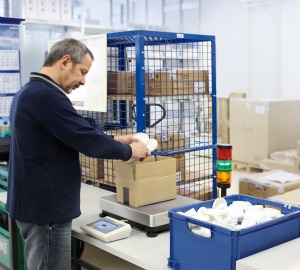
Boosting Efficiency with a Digital Platform Scale: The Versatile Solution for Modern Weighing Needs
Digital platform scales have become indispensable tools across a wide range of industries, from manufacturing and logistics to retail and healthcare. These versatile scales offer a variety of functions beyond basic weighing that can support streamlining operations and improving efficiency.
This article explores the key features and benefits of digital platform scales, highlighting their versatility and providing insights into selecting the right scale for your specific needs.
The Versatility of a Digital Platform Scale

Digital platform scales, like those provided by Tovatech from Kerrn, are designed to handle a variety of weighing and measurement tasks. Their multi-functionality allows businesses to consolidate their weighing equipment, reducing costs and simplifying operations.
These scales can be used for:
- Simple Weighing: Determine the weight of goods, packages, or materials.
- Counting: Count pieces by weight, ideal for handling large quantities of small parts.
- Checkweighing: Verify that items fall within a specified weight range, ensuring quality control and compliance.
- Percent Weighing: Measure the weight of a sample as a percentage of a reference weight, useful in recipe formulation and quality control.
- Dynamic Weighing: Weigh unstable or moving objects, such as animals or liquids.
- Recipe Formulation: Accurately weigh ingredients for recipes or formulations, ensuring consistency and quality.
- Data Logging and Analysis: Record and analyze weight data for tracking, inventory management, and quality control purposes.
Key Features to Consider During Selection
- Capacity and Readability: Choose a scale with a capacity that meets your weighing needs and a readability that provides the required level of precision. Kern scales offer capacities ranging from 3,100 to 151,000 grams.
- Platform Size and Material: Consider the size and material of the weighing platform. Stainless steel platforms are durable, easy to clean, and resistant to corrosion.
- Display and Interface: A clear and intuitive display simplifies operation and data interpretation. Look for features like backlighting, large digits, and user-friendly menus.
- Connectivity: Consider connectivity options, such as RS232 interfaces, for data transfer to computers or printers for record-keeping, labeling, and analysis.
- Power Options: Choose a scale with power options, such as AC power, battery power, or rechargeable batteries, that fit your needs.
- Additional Functions: Consider additional functions that can enhance efficiency and streamline your workflow, such as checkweighing, counting, percentage weighing, and data logging.
Ease of Use and Operation
Modern digital platform scales are designed with user-friendliness in mind. Features like intuitive touchscreens, clear menu structures, and plain-text labels simplify operation and minimize training time. Visual and audible signals, such as those used in checkweighing, provide clear feedback to the operator.
Calibration and Maintenance
Regular calibration is crucial for maintaining the accuracy of your digital platform scale. Many scales, like the Kern IKT, offer automatic calibration procedures that simplify the process. Establish a regular calibration schedule and follow the manufacturer’s instructions for optimal performance. Routine maintenance, such as cleaning the platform and checking for wear and tear, also contributes to the longevity and accuracy of the scale.
Choosing the Right Digital Platform Scale
Selecting the right digital platform scale requires careful consideration of your specific weighing needs, application requirements, and budget. By evaluating factors like capacity, readability, platform size, features, and connectivity options, you can choose a scale that optimizes your weighing operations and enhances efficiency.
Consulting with Tovatech’s digital scale specialists can help you navigate the options and make an informed decision. Call or chat with us today.
